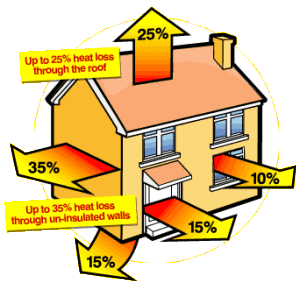Winter Weather Can Wear Down Your Philadelphia Property
There is recent news about the Colosseum in Italy experiencing crumbling and structural damage because of heavy snow in the recent weeks. The attraction has been closed to tourists so that officials are able to review the damage and prevent further destruction. While it may be a mild winter here in Philadelphia, this deterioration in faraway Italy got me to thinking about ways we can prevent snow and winter weather from damaging our own properties.

MAKE YOURSELF AWARE OF STEPS TO AVERT DAMAGE
- Remember that an abundance of snow fall is heavy and can cause trees and other objects to fall. Make sure to trim your treesproperly and shovel/put salt down before winter weather strikes.
- Freezing pipes can ultimately cause pipe bursting and cause a ton of money to fix. Pipes in attics and outside walls are the most vulnerable. Make sure your pipes are well insulated and that warm air within your home is able to get to the pipes. If you plan to be away, turn off water supply to the pipes.
- Your roof is an extremely vulnerable exterior spot on your house. Please make sure all of your roof shingles are fastened, as loose shingles can lead to the need for expensive repairs.
- Masonry with small cracks in it will allow water to come in, expand when it freezes, and ultimately cause larger cracks. Fix these small cracks with outdoor caulking to prevent this before it happens.
- When the weather warms and the snow begins to melt, make sure that there is a way for the water to drain away from your house; this is to prevent flooding. Shovel snow away from the house, especially from basement windows. Make sure drainage on the street is not blocked and clear a path for the water.

As a Philadelphia property management firm, we know how much it takes to make sure that you are prepared for the unpredictable weather. We hope that it continues to be beautiful and that spring is on its way, but please follow all the necessary precautions to make sure that you keep yourselves and your homes safe!
How to find the best “city” carWhat Does the Recent Surge in Gas Prices Mean for Philadelphia Residents?
We are all very used to oil prices fluctuating. Now, however, with Iran cutting off supplies to areas such as Great Britain and France, oil prices will sky rocket. What does that mean for us? Well, in the most basic sense of it, gas prices will go through the roof, a gallon of gas estimated to reach $5 by this summer. So, in an economic recession and with a major price increase, what are the smartest cars to purchase when you’re a Philadelphia resident?
BEST CITY CAR BASED ON MPG:
- The Nissan Leaf, by far, gets the best mileage per gallon – at a whopping 86 city/mpg. It’s MSRP is between $35,000-$37,000.
- The Scion xD, listed in the subcompact car category, gets 25 city/mpg which, surprisingly, is the best in its class. It is listed for between $15,000 and $17,000.
- The Honda Civic Hybrid is listed as the best in the small sedan class, getting 28 city/mpg. It’s MSRP is between $24,000 and $27,000.
- The Honda CR-Z, at 26 city/mpg, is the best in the sporty car category. It is reasonably priced at $19,000-$23,000. Remember, it has the added addition of being compact enough to squeeze into that small parking space on the street.
- For the best family-sized sedan, the Toyota Camry Hybrid XLE gets 32 city/mpg. This car is listed at around $27,500.
- Going for the luxury sedan? The Lexus HS Hybrid has an MSRP between $37,000 and $40,000 and gets an estimated 24 city/mpg
- SUV’s are obviously not as fuel-efficient, however, the Toyota Highlander Hybrid Limited is right up there with the Scion xD, getting 23 city/mpg. The MSRP is a little pricier at around $45,000.
- Minivans DO NOT get good gas mileage. The best one, the Toyota Sienna LE, gets 14 city/mpg and costs between $32,000 and $41,000.
- Finally, for the truck lovers out there, the Toyota Tacoma comes in at number one in the Pickup category, pulling in 13 city/mpg. You can find it priced between $22,000 and $27,000.

THE SMALLEST CARS:
The Volkswagon Beetle used to be one of the smallest cars on the street. At 168.4 inches long and 71.2 inches wide, use it to compare the size of these other compact vehicles.
- The Smart fortwo passion coupe, a two door and two seat car, is 105.6 inches long and 61.4 inches wide.
- The Fiat 500 Pop has two doors and seating for four. It is 139.6 inches long and 64.1 inches wide.
- The Ford Focus is a four door, five seater, and is 178 inches long and 104.2 inches wide.
- For a luxury car, the Lexus CT200h comes in at 170.1 inches long and 69.5 inches wide. It also has four doors and five seats.
OTHER COSTS WILL RISE
Rising oil costs will also cause Philadelphia residents to pay for other goods. Residents should expect increases in
- Public transportation costs are likely to rise to pay for their additional gas prices
- Plastic goods may rise in cost because plastic is made from oil
- Food prices will begin to raise to make up for farmers’ additional costs
- USPS, FedEx, and UPS prices will increase
- If you are receiving gas heat, these prices will become higher.
With all of these increases, here’s to hoping that Iran continues its oil trade with other nations, and that oil prices drop or, at the very least, plateau.
Embracing the Weather With Man’s Best FriendEnjoying the Philadelphia Weather With Your Dog
Well, it’s gorgeous outside for the second consecutive day this week, so what better to explore than the parks in the city. But, these are not any parks! They are parks dedicated to those little fur balls, those big bears, our best friends, our dogs. Philadelphia boasts a tons of dog parks all around the city. I am going to talk about just a fraction of them!
- This Philadelphia dog park is located at 900 N Orianna St and attracts a ton of loyal regular followers. A membership fee is required.
- Located where Aramingo Ave, E. Girard Ave., and Fletcher St. meet. This is a place where you can bring your dog and let him run free, as it as an off-leash Philadelphia dog park and is fully fenced in.
- Come to this off-leash fenced in dog park located at Front and Chestnut. This area is covered with mulch to reduce muddy dog prints!
- Bring your dog to 2nd and Catharine Sts, another off-leash, fenced in Philadelphia dog park that is perfect for you and your canine friends! There are great features here including water fountains, trees, tables, and lights so you are able to see at night time!

- Yearly membership fee is required at this off-leash, well-kept dog park, located S 11th and Lombard Sts.
- Fully fenced in, off-lease park, located at 1200 Wharton St. Come bring your dog here where there is gravel ground coverings and small stumps for your friendly friend to play on!
- This Philadelphia dog park is located at S 25th St and Spruce St. running along the Schuylkill River. It offers designated areas for smaller and larger dogs, and provides it’s patrons with biodegradable waste bags.

I hope that this was an informative tool for you Philadelphia dog owners! I hope that you have fun playing and running around with your four-legged friend! (bark)
Getting Ready for Anything
One of the most important steps you can take when you’re moving into a new Philadelphia rental property is to familiarize yourself with emergency procedures. Emergency procedures may involve more than locating the fire extinguisher or knowing where all of the exits in the building are located. Here are some ways you can make yourself fully aware of what to do in the worst case
MAKE A PHONE LIST:
Number one thing for your emergency procedures is to know who to call in a panic and what their numbers are. What if you can’t access your cell phone or your internet is down? Generation Y is so reliant on their smart phones that they forget that there are circumstances where technology is just not accessible. The smartest thing you can do is write down important phone numbers that you could need if something went awry.
- Know your local hospital
- Poison control hotline
- Police Station
- Fire Department
- Your doctors’ phone number
- Your insurance carriers’ phone number
CREATE THAT ACTION PLAN FOR EMERGENCY PROCEDURES:
It may seem unnecessary, but creating a plan for a catastrophic scenario is important.
- If you live alone in the Philadelphia region, let loved ones know where you’d go if something happened so they’re not frantic.
- Create a mini emergency kit with some water and an extra copy of those important phone numbers.
Just remember, it’s better to be safe than sorry. Planning ahead never hurt anyone!
Are Space Heaters Effective?Do Space Heaters Save You Money?
In these cold winter months… or, what used to be these cold winter months, people often spent a fortune on heating their homes. Now, with more energy-efficient central heating, costs may be lower, but people are still searching for ways to cut their bill; many buy space heaters as the solution. I had to find out if space heaters were really the better option, and, if so, which one I should purchase.
CENTRAL HEAT VS. SPACE HEATERS
- Localized spaces: Space heaters are great for areas that are getting inadequate heat from your centralized heating system; they are designed to heat specific areas or objects. If it’s colder in one room of your home, if you are only using one space in a large building, or if you are sensitive to the cold, using a space heater may benefit you and your money.
- Large places: In no way would it be more cost-effective for you to get multiple space heaters for throughout a large space. That is the job of your central heating unit. It would be much more expensive to run a couple tiny heaters as opposed to your larger one.
What is important here is the space heater’s intended use. When you use a space heater in a way in which it was not intended to be used, you are conceding to an increase in your bill. However, if you do it in the right way, as described above, it is important that you look for a heater that has good safety features and fits your design needs.

IF YOU CHOOSE TO BUY A SPACE HEATER, WHAT ELSE SHOULD YOU KNOW?
First, you are going to need to choose between the two main categories of space heaters: convection and radiant. Once you have decided which one you are going to go with, you need to locate a good option to purchase. I researched space heaters and will list the best and the most cost-efficient for you.
- Convection Heater: A type of convection heater that you may be better acquainted with is the ceramic heater. They use a liquid, such as oil, and an electric coil. This combination heats air quickly and disperses it evenly throughout a given space. Portable convection heaters are best for long-term usage in an entire room. In the case of ceramic heaters, the ceramic is usually placed within the heating system, reducing the risks of fires and injury to yourself or others.-Lasko 755320 – Ceramic Tower Heater, $48.96
–My Heat Personal Ceramic Heater, $17.99
–Crane Flat Panel Convection Heater, $39.98 - Radiant Heater: These types of heaters are best for heating a small space quickly; they heat a more focused line of sight. This is great for when you are sitting in your favorite chair watching TV, but is not so perfect for heating an entire room.-Optimus H-41190 9-Inch Dish Heater, $40.57
–Optimus Portable Fan Forced Radiant Heater, $24.99
–Crane EE-6353 Space Heater, $55.09
HEATING HAZARDS
With a space heater, you have a much higher risk of fire, death, and injury. Be sure to keep the heater at least 2 feet away from flammable items. Check out your heater before you purchase it and see what safety features it provides you. Be sure to comply with all directions that it gives you. Keep your children and your pets as far away from the heater as you can. Finally, never leave the space heater unattended.

FINAL THOUGHTS
If you don’t go the space heater route, there are some other ways to winter-proof your house. Add some insulation, change your furnace filter regularly, even buy some insulating curtains.
Wishing for you a nice winter that isn’t too cold!
So, if you remember, in Mid January, I posted about a great new Philadelphia Property Management tool which I came across – the Rat zapper. For those who don’t remember, the Rat Zapper sends an electronic charge through the rodent, and is activated by a motion sensor. By far this is the most humane and clean way to catch and dispose of mice and rats. It all sounded great, and for approximately $50 per unit, it’s not too expensive either (when compared to purchasing glue and poison over and over).
However, the real question is does it really work as advertised? I’ve used the unit in two Philadelphia properties which I manage, the first was an office space which had a small mouse problem due to holes in exposed brick which where providing access for the mice. The unit caught a mouse every single night for a couple of weeks straight – that’s 14 mice! The mouse problem seems to be eradicated. In this circumstance, I couldn’t have been happier. I just put a few pieces of my dog’s food in the back, and it worked wonders.
In the second property, I had very different results. Despite putting the rat zapper out for a couple of weeks (the first week with dog food as bat, and the second with peanut butter), I caught nothing. I know there were rodents present, as I could see their droppings. I moved the unit around to several different locations, thinking that my placement might have been the issue. Ultimately, my guess is that in the second property I had rats, rather than mice. Rats seem to be a little bit smarter, and harder to be tricked.
In conclusion, if you’ve got a mouse problem – I highly recommend this product. However, for rats, I would recommend that you keep on searching for a safe alternative!

